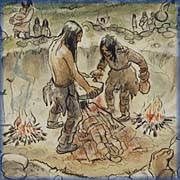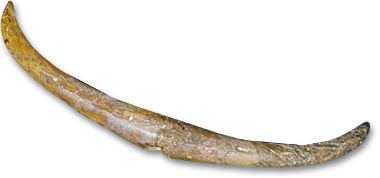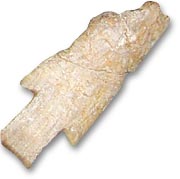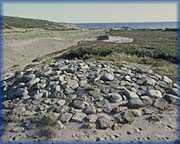|
An Offering by the Sea
 his walrus tusk was
found at L'Anse Amour, Labrador, in one of Atlantic Canada's
most spectacular archaeological finds. The 7,500-year-old site
contained a circular mound, constructed of large flagstones.
Careful excavation revealed the skeleton of a young boy, lying
buried several metres below the surface, at the heart of the
mound. Offerings buried with the boy included what appeared to
be a set of hunting tools - perhaps for hunting walrus.
The kit contained stone and bone spearheads, a walrus ivory
toggling harpoon head and hand toggle,
ceremonial paint objects and a bird-bone whistle. It is
intriguing to suppose that the boy may have been killed while
on a walrus hunt. his walrus tusk was
found at L'Anse Amour, Labrador, in one of Atlantic Canada's
most spectacular archaeological finds. The 7,500-year-old site
contained a circular mound, constructed of large flagstones.
Careful excavation revealed the skeleton of a young boy, lying
buried several metres below the surface, at the heart of the
mound. Offerings buried with the boy included what appeared to
be a set of hunting tools - perhaps for hunting walrus.
The kit contained stone and bone spearheads, a walrus ivory
toggling harpoon head and hand toggle,
ceremonial paint objects and a bird-bone whistle. It is
intriguing to suppose that the boy may have been killed while
on a walrus hunt.
|

Walrus Tusk (Replica)
L'Anse Amour, Labrador
ca. 5500 B.C.
Length: 10.75 inches
Collection: Newfoundland Museum, St. John's, Newfoundland, EiBf-4:121c
|

|

Artistic interpretation of a burial
ceremony at L'Anse-Amour
Illustration: Steve Broomer, 1983
(Commissioned by the Canadian Museum of Civilization)
|

Socketed Bone Projectile Point (Replica)
L'Anse Amour, Labrador
ca. 5500 B.C.
Length: 5 inches
Collection: Newfoundland Museum, St. John's, Newfoundland, EiBf-4:116c
|

Walrus Ivory Hand Toggle (Replica)
L'Anse Amour, Labrador
ca. 5500 B.C.
Length: 6.5 inches
Collection: Newfoundland Museum, St. John's, Newfoundland, EiBf-4:110c
|

|

Barbed Bone Projectile Point (Replica)
L'Anse Amour, Labrador
ca. 5500 B.C.
Length: 2.75 inches
Collection: Newfoundland Museum, St. John's, Newfoundland, EiBf-4:11c
|

|

Restored burial mound at L'Anse-Amour,
Labrador, 1984
(Photo: David Keenlyside, Canadian Museum of Civilization)
|
|
|





